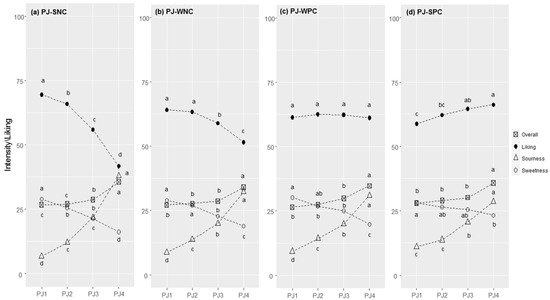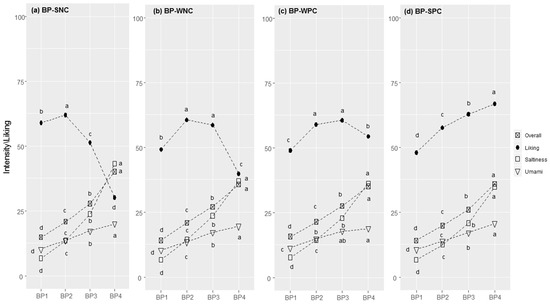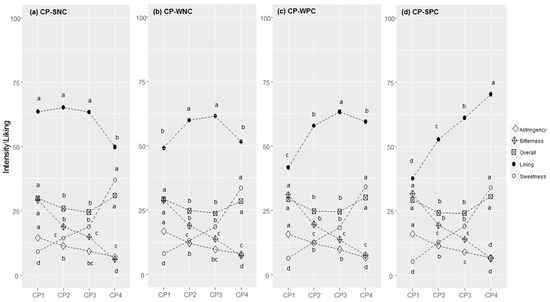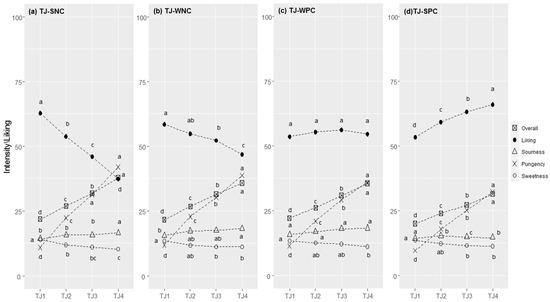Error in Figures
In the original publication [1], there was a mistake in “Figure 2, Figure 3, Figure 4,
and Figure 5” as published. “In the mentioned figures, letters indicating the statistical significance of the differences in intensity/liking between the samples in each cluster are completely missed, and if reported they refer to the statistical significance between clusters instead of between samples”. The corrected “Figure 2, Figure 3, Figure 4, and Figure 5” appear below. The authors apologize for any inconvenience caused and state that the scientific conclusions are unaffected. This correction was approved by the Academic Editor. The original publication has also been updated.

Figure 2.
Pear juice (PJ) responses in each cluster (SNC = Strong Negative Correlation (a), WNC = Weak Negative Correlation (b), WPC = Weak Positive Correlation (c), and SPC = Strong Positive Correlation (d)): perceived intensity (gLM scale) and liking (LAM scale) averages for each concentration level of citric acid (1–4). Within each cluster, different letters indicate significant differences in intensity/liking between concentration levels (p < 0.05).

Figure 3.
Bean purée (BP) responses in each cluster (SNC = Strong Negative Correlation (a), WNC = Weak Negative Correlation (b), WPC = Weak Positive Correlation (c), and SPC = Strong Positive Correlation (d)): perceived intensity (gLM scale) and liking (LAM scale) for bean purée samples at increasing concentrations of sodium chloride (1–4). Within each cluster, different letters indicate significant differences in intensity/liking between concentration levels (p < 0.05).

Figure 4.
Chocolate Pudding (CP) responses in each cluster (SNC = Strong Negative Correlation (a), WNC = Weak Negative Correlation (b), WPC = Weak Positive Correlation (c), and SPC = Strong Positive Correlation (d)): perceived intensity (gLM scale) and liking (LAM scale) for samples at increasing concentrations of sucrose (1–4). Within each cluster, different letters indicate significant differences in intensity/liking between concentration levels (p < 0.05).

Figure 5.
Tomato juice (TJ) responses in each cluster (SNC = Strong Negative Correlation (a), WNC = Weak Negative Correlation (b), WPC = Weak Positive Correlation (c), and SPC = Strong Positive Correlation (d)): perceived intensity (gLM scale) and liking (LAM scale) for samples at increasing concentrations of capsaicin (1–4). Within each cluster, different letters indicate significant differences in intensity/liking between concentration levels (p < 0.05).
Reference
- Endrizzi, I.; Cliceri, D.; Menghi, L.; Aprea, E.; Charles, M.; Monteleone, E.; Dinnella, C.; Spinelli, S.; Pagliarini, E.; Laureati, M.; et al. Relationships between Intensity and Liking for Chemosensory Stimuli in Food Models: A Large-Scale Consumer Segmentation. Foods 2022, 11, 5. [Google Scholar] [CrossRef] [PubMed]
Publisher’s Note: MDPI stays neutral with regard to jurisdictional claims in published maps and institutional affiliations. |
© 2022 by the authors. Licensee MDPI, Basel, Switzerland. This article is an open access article distributed under the terms and conditions of the Creative Commons Attribution (CC BY) license (https://creativecommons.org/licenses/by/4.0/).